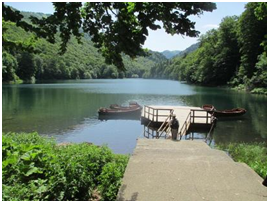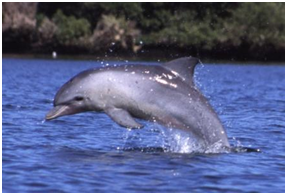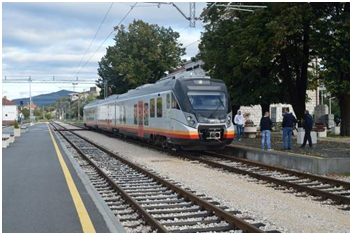About Montenegro
Montenegro is a country in Southeastern Europe on the Adriatic Sea. It borders Bosnia and Herzegovina to the north; Serbia to the east, Albania to the south and Croatia to the west. Montenegro has an area of 13,812 square kilometres and a population of 678,901. Its capital Podgorica is one of the twenty-three municipalities in the country. Cetinje is designated as the Old Royal Capital.
The country's name derives from Venetian and translates to "Black Mountain", deriving from the appearance of Mount Lovćen when covered in dense evergreen forests. The native name Crna Gora came to denote the majority of contemporary Montenegro only in the 15th century.
Biodiversity and nature of Montenegro
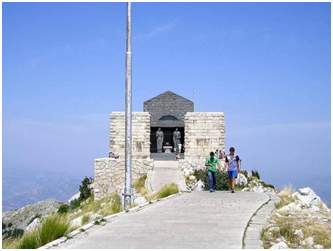
Mausoleum of metropolitan Petar II Petrović-Njegoš,
in Lovćen
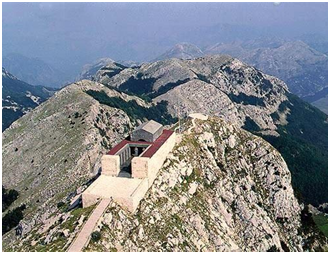
Mount Lovćen
Montenegro ranges from high peaks along its borders with Serbia, Kosovo, and Albania, a segment of the Karst of the western Balkan Peninsula, to a narrow coastal plain that is only 1.5 to 6 kilometres (1 to 4 miles) wide. The plain stops abruptly in the north, where Mount Lovćen and Mount Orjen plunge into the inlet of the Bay of Kotor.
The mountains of Montenegro include some of the most rugged terrain in Europe, averaging more than 2,000 metres (6,600 feet) in elevation. One of the country's notable peaks is Bobotov Kuk in the Durmitor mountains, which reaches a height of 2,522 m (8,274 ft).
Montenegro is a member of the International Commission for the Protection of the Danube River, as more than 2,000 km2 (772 sq mi) of the country's territory lie within the Danube catchment area.
The diversity of the geological base, landscape, climate, and soil, and the position of Montenegro on the Balkan Peninsula and Adriatic Sea, created the conditions for high biological diversity, putting Montenegro among the "hot-spots" of European and world biodiversity. The number of species per area unit index in Montenegro is 0.837, which is the highest index recorded in any European country.
Economy and infrastructure of Montenegro
The economy of Montenegro is mostly service-based and is in late transition to a market economy. According to the International Monetary Fund, the nominal GDP of Montenegro was $4.114 billion in 2009. The GDP PPP for 2009 was $6.590 billion, or $10,527 per capita. According to Eurostat data, the Montenegrin GDP per capita stood at 41% of the EU average in 2010. The Central Bank of Montenegro is not part of the euro system but the country is "euroised", using the euro unilaterally as its currency.
In 2007, the service sector made up 72.4% of GDP, with industry and agriculture making up the rest at 17.6% and 10%, respectively. There are 50,000 farming households in Montenegro that rely on agriculture to fill the family budget.
The Montenegrin road infrastructure is not yet at Western European standards. Despite an extensive road network, no roads are built to full motorway standards. Construction of new motorways is considered a national priority, as they are important for uniform regional economic development and the development of Montenegro as an attractive tourist destination.
Current European routes that pass through Montenegro are E65 and E80.
The backbone of the Montenegrin rail network is the Belgrade–Bar railway, which provides international connection towards Serbia. There is a domestic branch line, the Nikšić-Podgorica railway, which was operated as a freight-only line for decades, and is now also open for passenger traffic after the reconstruction and electrification works in 2012.
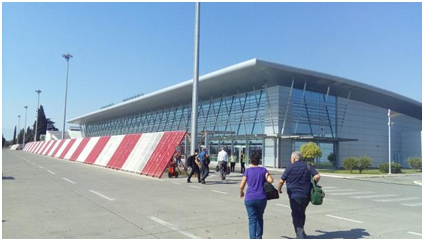
Podgorica Airport Bridge
Montenegro has two international airports, Podgorica Airport and Tivat Airport. The two airports served 1.1 million passengers in 2008. Montenegro Airlines is the flag carrier of Montenegro.
Montenegro has both a picturesque coast and a mountainous northern region. The country was a well-known tourist spot in the 1980s. With a total of 1.6 million visitors, the nation is the 36th (out of 47 countries) most visited country in Europe.
The Montenegrin Adriatic coast is 295 km (183 mi) long, with 72 km (45 mi) of beaches, and with many well-preserved ancient old towns. National Geographic Traveler (edited once in decade) features Montenegro among the "50 Places of a Lifetime", and Montenegrin seaside Sveti Stefan was used as the cover for the magazine. The coast region of Montenegro is considered one of the great new "discoveries" among world tourists. In January 2010, The New York Times ranked the Ulcinj South Coast region of Montenegro, including Velika Plaza, Ada Bojana, and the Hotel Mediteran of Ulcinj, as among the "Top 31 Places to Go in 2010" as part of a worldwide ranking of tourism destinations.
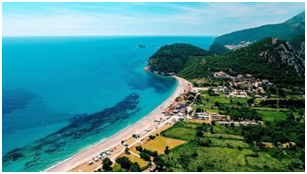
Buljarica Beach
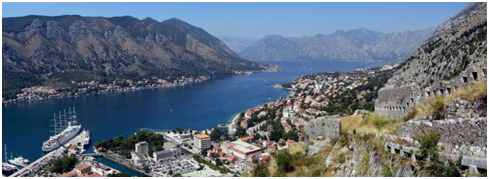
Bay of Kotor
Montenegro has been historically at the crossroads of multiculturalism and over centuries this has shaped its unique form of co-existence between Muslim and Christian population.[70] Montenegrins have been, historically, members of the Serbian Orthodox Church (governed by the Metropolitanate of Montenegro and the Littoral), and Serbian Orthodox Christianity is the most popular religion today in Montenegro.
Religious institutions from Montenegro all have guaranteed rights and are separate from the state. The second largest religion is Islam, which amounts to 19% of the total population of the country. There is also a small Roman Catholic population, divided between the Archdiocese of Antivari headed by the Primate of Serbia and the Diocese of Kotor that is a part of the Church of Croatia.
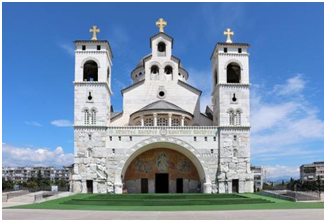
Orthodox Cathedral of the Resurrection of Christ, Podgorica
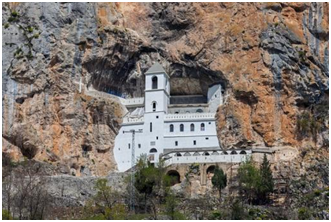
Ostrog Monastery − the famous and most popular Christian pilgrimage site in Montenegro
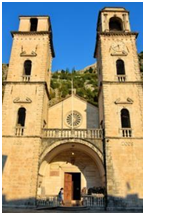
The Cathedral of Saint Tryphon – old town Kotor
The culture of Montenegro has been shaped by a variety of influences throughout history. The influence of Orthodox, Ottoman (Turk), Slavic, Central European, and seafaring Adriatic cultures (notably parts of Italy, like the Republic of Venice) have been the most important in recent centuries. Montenegro has many significant cultural and historical sites, including heritage sites from the pre-Romanesque, Gothic and Baroque periods. Montenegro's medieval monasteries contain thousands of square metres of frescos on their walls.
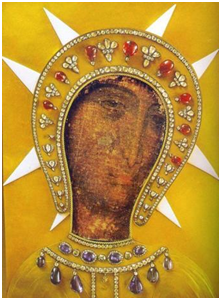
Our Lady of Philermosthe patroness of Montenegro, one of the first Christian icons, according to legend painted by St. Luke, on Cetinje.
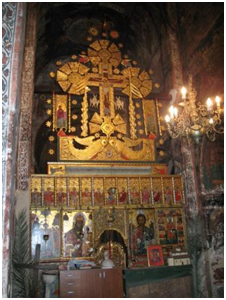
One of the most ornamented Iconostasis, Saint Nicholas Church, Bijelo Polje
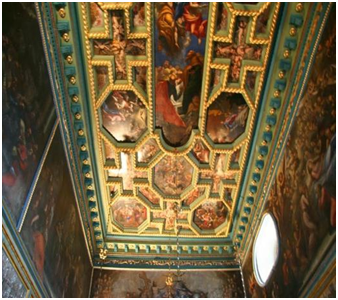
Ornate ceiling in the church of Assumption of the Most Holy Mother of God, Island Our Lady of the Rocks, Perast

